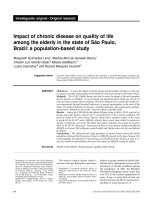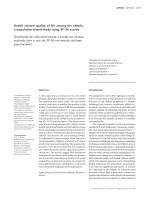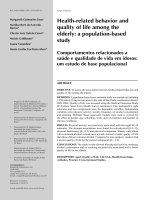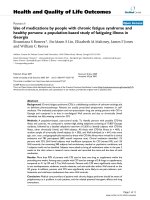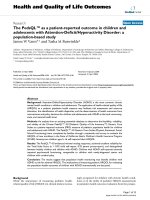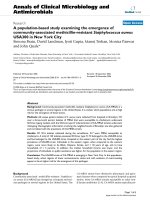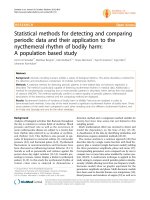A population based study 2
Bạn đang xem bản rút gọn của tài liệu. Xem và tải ngay bản đầy đủ của tài liệu tại đây (1.69 MB, 134 trang )
91
Chapter 3:
Results
92
3.1. Genetic alterations of the BRCA1 gene in Singapore Malay women with breast/
ovarian cancer.
3.1.1. BRCA1 mutations
The mutation analysis of the entire coding region of BRCA1 performed on blood samples
from 76 and 20 Malay breast and ovarian cancer patients respectively, selected for either
early-onset or with family history of breast and/or ovarian cancer, revealed twelve
different BRCA1 alterations (Tables 7 and 8). These sequence alterations were identified
in 16 unrelated patients and they span the entire coding region of BRCA1. They
comprised one frameshift mutation (c.2845insA), two missense mutations (c.335C>G
and c.778C>A) and nine polymorphisms (c.233G>A, c.432-44G>A, c.420+26CA>AC,
c.561-34T>C, c.5106-68A>G, c.5106-92A>G, c.5272+72G>C, c.5272+73G>A and
c.5451+85delC). Four of these variants are novel and they are c.778C>A, c.432-44G>A,
c.420+26CA>AC and c.5451+85delC (Figure 13). All sequence variants were designated
according to the Human Genome Organization (HUGO) recommendations (Den Dunnen
JT and Antonarakis SE, 2000).
93
n = With no family history
Br/Ov Other Ca
81 15 (18.5%) 9 (11.1%) 57 (70.4%)
15 15 (100.0%) 0 0
96 30 (31.3%) 9 (9.4%) 57 (59.4%)
Fallopian tube cancer 1 0 0 1
26 4 (15.4%) 1 (3.8%) 21 (80.8%)
30 3 (10.0%) 1 (3.3%) 26 (86.7%)
56 7 (12.5%) 2 (3.6%) 47 (83.9%)
84 NK NK NK
167 9 (5.4%) 4 (2.4%) 154 (92.2%)
17 3 (17.6%) 2 (11.8%) 12 (70.6%)
184 12 (6.5%) 6 (3.3%) 166 (90.2%)
23 0 0 23 (100%)
relative. Percentages are in brackets. Br - breast; Ov - ovarian; Ca - cancer; yrs - years; NK - not known
Breast cancer (age of onset unknown)
Methylation analysis of BRCA1 promoter in Singapore women
with breast cancer
cancer and above 50 years for ovarian cancer. Family history is defined as the presence of cancer on either maternal or paternal side up to second degree
Matched tumour and normal tissue from same patient
Note: Early-onset - 45 years and below for breast cancer and 50 years and below for ovarian cancer. Late-onset - Above 45 years for breast
50 years and below
above 50 yrs
All
Early-onset
With family history
Table 7. Summary of BRCA1 genetic / epigenetic study samples. The classification is based on age of onset and family history.
Mutation analyses of the entire coding of BRCA1 in Singapore Malay women
with breast/ovarian cancer
Paraffin-embedded tissues
Blood
Healthy controls, Malays
Early-onset (breast/ovarian cancer)
Late-onset (breast/ovarian cancer)
Mutation analysis of the recurrent c.2845insA mutation in Singapore Malay women
Blood from FTA
All (breast/ovarian cancer)
Late-onset
All
94
Table 8. BRCA1 mutations found in Singapore Malay women with breast/ovarian cancer.
Sequence alteration DNA source Exon Amino acid Total no. of BC No. of BC No. of OC # times recorded Clinically
change and OC cases cases cases in BIC* important**
n=236 n=189 n=47
Frameshift mutation Blood + Paraffin +
c.2845insA FTA cards 11 N909frameshiftX5 6 3 3 5 yes
n=96 n=76 n=20
Missense mutation
c.335C>G 6 S72R 1 1 0 1 unknown
c.778C>A (Novel) 10 S220Y 1 1 0 Nil unknown
Polymorphism
c.233G>A 3 No change 3 2 1 17 no
c.432-44G>A (Novel) Blood 6 Intronic 1 1 0 Nil unknown
c.420+26CA>AC(Novel) 6 Intronic 1 1 0 Nil unknown
c.561-34T>C
8 Intronic 1 1 0 8 no
c.5106-68A>G
17 Intronic 2 2 0 1 no
c.5106-92A>G
17 Intronic 2 2 0 6 no
c.5272+72G>C
18 Intronic 1 1 0 Nil
c.5272+73G>A
18 Intronic 2 2 0 1 unknown
c.5451+85delC (Novel) 21 Intronic 2 2 0 Nil unknown
n=84 n=84
Missense mutation
c.2731C>A 11 P871T 1 1 Nil 1 unknown
Paraffin
Polymorphism
c.2754A>C (Novel) 11 A878A 1 1 Nil Nil unknown
Note: BC - breast cancer, OC - ovarian cancer and BIC - Breast Information Core Database. * Figures accurate as of 20 May 2007. ** Based on the opinion of BIC
steering committee that the sequence change interferes with gene function and results in increased risk of cancer (BIC database).
95
Blood collected, using FTA cards, from 56 sporadic Malay breast/ovarian patients was
investigated for the recurrent BRCA1 c.2845insA mutation only and none of these
patients had the recurrent mutation. In addition, 84 paraffin-embedded sporadic Malay
breast tumour samples were analyzed for the recurrent mutation and all of them tested
negative (Table 8). However, two other novel sequence variants, a missense mutation
(c.2731C>A) and a neutral polymorphism (c.2754A>C), were identified. In summary, the
recurrent BRCA1 c.2845insA mutation was detected in 6 out of a total of 236 breast and
ovarian cancer cases (whole blood, FTA and paraffin sources) (Table 8). This recurrent
mutation was found mainly in cases with early-onset of cancer but not in late-onset cases.
None of the 184 unrelated age-matched normal subjects was found to carry the recurrent
BRCA1 c.2845insA mutation.
3.1.2. BRCA1 mutations, age of onset of cancer and family history of cancer
In this study, the recurrent BRCA1 c.2845insA mutation was detected in six unrelated
patients of which three had breast cancer and the remaining three had ovarian cancer
(Table 8, Figure 12). Out of the six patients with the recurrent BRCA1 c.2845insA
mutation, four patients (N536, N587, N610 and N521) had at least a first or second
degree relative with breast or ovarian cancer (Table 9). Patients N536, N587 and N610
were early-onset breast cancer cases while N521 was an early-onset ovarian cancer case.
The recurrent mutation was also detected in an early-onset ovarian cancer patient, N590,
who had a second-degree relative diagnosed with stomach cancer.
96
N 1 2 3 4 5 6
N 1 2 3 4 5 6
Figure 12. The recurrent BRCA1 c.2845insA deleterious mutation identified in six Malay
breast and ovarian cancer patients. a. PTT gel and b. SSCP gel. N – normal (healthy
control). Breast and ovarian cancer patients are labeled as samples 1 to 6 representing
N521, N536, N576, N587, N590 and N610/#014 respectively.
The three missense mutations detected in this study were of unknown clinical
significance and were found in three separate breast cancer patients. The first missense
mutation, c.778C>A (S220Y), was identified in a patient (N536) diagnosed with early-
onset breast cancer whose sister was diagnosed with breast cancer at 33 years of age and
father diagnosed with colon cancer at the age of 58 years (Table 9, Figure 13). In
addition, this patient was also found to be carrying the deleterious c.2845insA mutation.
This missense mutation is novel which causes an amino acid change within the BRCA1
NLS domain (Wu LC, et al, 1996; Bork P, et al, 1997; Hashizume R, et al, 2001). The
second missense, c.335C>A (S72R), found in a patient diagnosed with early-onset breast
cancer with no family history of cancer, is a rare mutation having only been described
once in the BIC database (Table 10, Figure 13). This mutation causes an amino acid
Variant band
Variant band
Truncated protein
(~106kDa)
Normal (220kDa)
a
b
97
change within the BRCA1 RING finger structural domain, which is in close proximity
with the RING finger motif. The third missense mutation, c.2731C>A (P871T) identified
in a breast cancer patient, T27, of unknown age of diagnosis and family history status has
been reported once in the BIC database (Table 10). This mutation occurs within BRCA1
NLS region (Bork P, et al, 1997).
Table 9. BRCA1 mutations in Malay patients with family history of cancer.
Note: yrs - years ; ins - insertion; del - deletion; IVS - intronic variant sequence; IP -
intronic polymorphism; MM - missense mutation; FS - frameshift mutation. Patients with
the framshift c.2845insA mutation are in bold.
Out of ten polymorphisms detected in this study, two were neutral polymorphisms and
eight were intronic mutations (Table 8, Figure 13). The first neutral polymorphism,
c.233G>A (K38K) was detected in two breast cancer patients (N33 and N522) and one
Patient #
Age
Family history
Mutation summary
Breast cancer
DNA source from blood
N536
35
1. Sister, Breast 33yrs;
1. c.2845insA; 914STOPTGA (FS)
2. Father, Colon 58yrs
2. c.778C>A; Ser220Tyr; S220Y (MM)
N587
44
1. Mother, Breast 60yrs
1. c.2845insA; 914STOPTGA (FS)
2. Maternal aunt, Breast 50+yrs
2. c.5272+72G>C; IVS18+72G>C (IP)
N610/#014
35
1. Mother, Ovary 49yrs
1. c.2845insA; 914STOPTGA (FS)
2. Maternal aunt, cancer type unknown
2. c.5451+85delC; IVS21+85delC (IP)
N599
29
1. Maternal grandfather, Colon 70yrs
1. c.5106-68A>G; IVS16-68A>G (IP)
2. c.5106-92A>G; IVS16-92A>G (IP)
Ovarian cancer
DNA source from blood
N521
49
1. Sister, Breast 37yrs
1. c.2845insA; 914STOPTGA (FS)
2. Half maternal aunt, Breast 30yrs
3. Maternal cousin, Breast 40yrs
N590
40
1. Maternal aunt, Stomach (age unknown)
1. c.2845insA; 914STOPTGA (FS)
N658
53
1. Sister, Ovary (age unknown)
1. c.5272+73G>A; IVS18+73G>A (IP)
98
ovarian cancer patient (N625). All three carriers were early-onset cases with no family
history of cancer. This polymorphism has been described 17 times in the BIC database.
The second neutral polymorphism, c.2754A>C (A878A), is a novel mutation and occurs
within BRCA1 NLS region. This polymorphism was identified in a breast cancer patient
(T36) of unknown age of diagnosis and family history status (Table 10).
The eight intronic variants, all detected in breast cancer patients, were IVS5-44G>A,
IVS6+26CA>AC, IVS7-34T>C, IVS16-68A>G, IVS16-92A>G, IVS18+72G>C,
IVS18+73G>A and IVS21+85delC (Table 8, Figure 12). Four intronic variants, IVS7-
34T>C, IVS16-68A>G, IVS16-92A>G and IVS18+73G>A, have been described
previously while the remaining four intronic variants, IVS5-44G>A, IVS6+26CA>AC,
IVS18+72G>C and IVS21+85delC, are novel (BIC database).
The intronic variants, IVS16-68A>G and IVS16-92A>G, were identified in two unrelated
early-onset breast cancer patients, N599 and N616. Patient N599 had a maternal
grandfather diagnosed with colon cancer at the age of 70 years while N616 had no family
history of cancer (Tables 9 and 10). The BRCA1 variant, IVS7-34T>C, was found in an
early-onset breast cancer patient, N511, who had no family history of cancer (Table 10).
The intronic variant, IVS18+73G>A, was identified in two samples, a breast and an
ovarian cancer patients. Patient N640 was diagnosed with early-onset breast cancer and
no family history of cancer while N658, diagnosed with late-onset ovarian cancer, had a
stepsister diagnosed with ovarian cancer at an unknown age (Tables 9 and 10).
99
Two of the novel intronic variants, IVS5-44G>A and IVS6+26CA>AC, were identified
in the same patient, N591, diagnosed with early-onset breast cancer with no family
history of cancer (Table 10). In addition, this patient was also found to be carrying the
missense mutation, c.335C>G. The third novel intronic mutation, IVS18+72G>C, was
found in an early-onset breast cancer patient whose mother and maternal aunt were
diagnosed with breast cancer at 60 and 50+ years of age (Table 9). Meanwhile, the fourth
novel intronic variant, IVS21+85delC, was identified in two unrelated early-onset breast
cancer patients, N537 and N610. Patient N537 had no family history of cancer while the
mother of patient N610 was diagnosed with ovarian cancer at 49 years of age (Tables 9
and 10). In addition, N610 also had a maternal aunt diagnosed with an unknown cancer
type and was found to be carrying the deleterious c.2845insA mutation.
100
Table 10. BRCA1 mutations in Malay patients without or unknown family history of
cancer.
Note: yrs - years ; ins - insertion; del - deletion; IVS - intronic variant sequence; NP -
neutral polymorphism; IP -intronic polymorphism; MM - missense mutation; FS -
frameshift mutation. Patient with the frameshift c.2845insA mutation is in bold.
Patient #
Age
Family history
Mutation summary
Breast cancer
DNA source from blood
N33/N389
38
Nil
1. c.233G>A; Lys38Lys; K38K (NP)
N522
32
Nil
1. c.233G>A; Lys38Lys; K38K (NP)
N591/A0062
41
Nil
1. c.335C>G; Ser72Arg; S72R (MM)
2. c.432-44G>A; IVS5-44G>A (IP)
3. c.420+26CA>AC; IVS6+26CA>AC (IP)
N511
34
Nil
1. c.561-34T>C; IVS7-34T>C (IP)
N616
35
Nil
1. c.5106-68A>G; IVS16-68A>G (IP)
2. c.5106-92A>G; IVS16-92A>G (IP)
N640
45
Nil
1. c,5272+73G>A; IVS18+73G>A (IP)
N537
43
Nil
1. c.5451+85delC; IVS21+85delC (IP)
DNA source from paraffin
T27
U
Unknown
1. c.2731C>A; Pro871Thr; P871T (MM)
T36
U
Unknown
1. c.2754A>C; Ala878Ala; A878A (NP)
Ovarian cancer
DNA source from lymphocytes
N576
50
Nil
1. c.2845insA; 914STOPTGA (FS)
N625
42
Nil
1. c.233G>A; Lys38Lys; K38K (NP)
101
Figure 13. Ten BRCA1 genetic variants detected in Malay women with breast/ovarian
cancer by SSCP. a – Exon 3 c.233G>A (patient N33/389); b – Exon 10 c.778C>A
(patient N536); c – Exon 8 IVS7-34T>C (patient N511); d - Exon 21 IVS21+85delC
(patient N610/#014); e - Exon 18 IVS18+73G>A (patient N587); f – Exon 17 IVS16-
68A>G and IVS16-92A>G (patient N599) and g – Exon 6 c.335C>G, IVS5-44G>A and
IVS6+26CA>AC (patient N591). Variant bands are identified with arrows. Lane 1 of
each gel depicts the SSCP profile from a normal control; Lane 2 of each gel depicts the
SSCP profile from a patient.
a
b
c
d
e
f
g
Exon 3
1 2
Exon 21
1 2
Exon 6
1 2
Exon 18
1 2
Exon 17
1 2
Exon 10
1 2
Exon 8
1 2
c.233G>A
c.233G>A
c.778C>A
IVS7-34T>C
IVS21+85delC
IVS16-68A>G
and
IVS16-92A>G
c.335C>G
IVS5-44G>A
and
IVS6+26CA>AC
IVS18+73G>A
a
b
c
d
e
f
g
Exon 3
1 2
Exon 21
1 2
Exon 6
1 2
Exon 18
1 2
Exon 17
1 2
Exon 10
1 2
Exon 8
1 2
c.233G>A
c.233G>A
c.778C>A
IVS7-34T>C
IVS21+85delC
IVS16-68A>G
and
IVS16-92A>G
c.335C>G
IVS5-44G>A
and
IVS6+26CA>AC
IVS18+73G>A
102
3.1.3. The recurrent BRCA1 c.2845insA mutation detected in Malay fallopian tube
cancer patient.
The recurrent frameshift mutation BRCA1 c.2845insA was detected in a fallopian tube
cancer patient, N633 (Figure 14). This patient was diagnosed at the age of 45 years and
had no reported family history of breast/ovarian cancer. Following genetic counseling,
the patient’s mother, three daughters, and one stepsister elected to undergo predictive
testing and all, but her youngest daughter N662, were also found to be carriers of this
mutation (Figures 14 and 15). Recommendation of closer surveillance was offered to
unaffected relatives found carrying the founder mutation.
WT N633 N655 N671 N644 N651 N662
Figure 14. Detection of the recurrent BRCA1 c.2845insA mutation in a Malay fallopian
tube cancer patient (N633) together with five other family members (N655, N671, N644,
N651 and N662) using the SSCP method. Arrows indicate variant bands.
103
Figure 15. Recurrent BRCA1 c.2845insA mutation analysis of a Malay fallopian tube
cancer patient with five other family members. Filled circle indicates the proband N633.
FTC – fallopian tube cancer; + indicate individuals detected positive for c.2845insA; -
indicate individual tested negative for c.2845insA. yrs – years.
3.1.4. Absence of BRCA1 genomic rearrangements in Malay breast/ovarian cancer
patients.
Eighty breast/ovarian cancer patients, who previously tested negative for BRCA1
mutations by SSCP and PTT, were selected for BRCA1 genomic rearrangement
screening. No BRCA1 genomic rearrangement was found, using the MLPA technique, in
the 80 Malay breast and ovarian cancer patients analyzed. A novel BRCA1 exon 13-15
deletion, identified in an ovarian cancer patient of Indian ethnicity, was used as a positive
control in the rearrangement screening (Figure 16). This was part of a study carried out in
N633
FTC
45yrs
33yrs
N671
30yrs
28yrs
N655
63yrs
N644
28yrs
N651
26yrs
N662
20yrs
+
+
+
+
-
N633
FTC
45yrs
33yrs
N671
30yrs
28yrs
N655
63yrs
N644
28yrs
N651
26yrs
N662
20yrs
+
+
+
+
-
+
104
our laboratory in which three different BRCA rearrangements were detected in three
unrelated non-Malay Singapore patients with breast/ovarian cancer (Lim YK, et al,
2007).
Figure 16. Electrophoregrams showing profiles of a Malay breast cancer patient, N510,
and a novel BRCA1 rearrangement identified in an ovarian cancer patient of Indian
ethnicity. No rearrangement was detected in the Malay breast cancer patient. A
rearrangement of BRCA1 exon 13-15 deletion, as shown above, with reduced peaks for
the corresponding exons (denoted by arrows) was used as positive control for BRCA1
genomic rearrangement analysis in Malay samples. (Lim YK, et al, 2007).
Exon 13-15 deletion (positive control)
Malay breast cancer patient, N510
Exon 13-15 deletion (positive control)
Malay breast cancer patient, N510
105
3.2. BRCA1 haplotype analysis.
3.2.1. Haplotyping of Malay breast/ovarian cancer patients and the general Malay
population.
Three BRCA1 intragenic markers, D17S1323 (Intron 12), D17S1322 (Intron 19) and
D17S855 (Intron 20), located on chromosome 17q21, were analyzed in 124
breast/ovarian cancer samples and 164 controls (Figure 17).
D17S1323
Results of haplotyping at the D17S1323 marker showed that the allele lengths in the
general Malay population were distributed between 135 to 169 base pairs (bp) (Table 11,
Figure 18). The alleles at the D17S1323 marker were designated according to sizes where
alleles of sizes 134.1 to 136.0 were designated as 135, 136.1 to 138.0 as 137, 138.1 to
140.0 as 139 and so forth (Table 11). The two most common alleles in cancer patients for
D17S1323 were the 153 bp and 159 bp alleles found in 22.6% and 23.8% respectively, of
all unselected breast/ovarian cancer patients. Allele 159 bp was the most common allele
detected in the controls (38.4%). Statistical significance was seen for the prevalence of
nine different alleles (with lengths of 149, 151, 153, 155, 157, 159, 163, 165 and 167 bp)
when comparing between all cancer patients and controls, with p<0.05 (Table 11).
The data indicated that five of the 9 alleles, with sizes at 149, 151, 153, 155 and 157 bp,
were found to be more prevalent in all cancer patients than in controls (Figure 18, Table
11). The relative risk (RR) of these alleles was calculated using the following formula:
106
{[No. of cancer cases with shared allele / (No. of cancer cases and controls with shared
allele)] / [No. of cancer cases without shared allele / (No. of cancer cases and controls
without shared allele)]}. The 149, 151, 153, 155 and 157 bp alleles appeared to be
associated with increased risk of developing unselected breast/ovarian cancer with
relative risks (RR) of 1.86, 1.95, 2.35, 1.98 and 1.80 respectively. A 139 bp allele, with
RR of 3.0, was associated with increased risk of early-onset breast/ovarian cancer. In
contrast, four alleles at lengths of 159, 163, 165 and 167 bp were found to be in higher
proportions in the controls than in all cancer patients (where p<0.05) with RR of 0.67,
0.24, 0.32 and 0.16 respectively.
A
B
C
A
B
C
A
B
C
Figure 17. A representation of the
haplotype analysis in 3 breast cancer
patients. A. N452 - with allele sizes of
143 and 151 bases at D17S1323 (Intron
12); B. N523 - with allele sizes of 116
and 122 bases at D17S1322; and C. N601
- with allele sizes of 157 and 163 bases at
D17S855. Arrows in bold indicate allele
peaks.
107
Figure 18. Allele distribution of the D17S1323 (BRCA1 Intron 20) marker in
Singapore Malay women with breast/ovarian cancer
0
5
10
15
20
25
30
35
40
45
134-5
136
-
7
1
38
-9
14
0
-1
142-3
1
44
-5
14
6
-7
148-9
1
50
-1
15
2
-3
154-5
156
-
7
1
58
-9
16
0
-1
162-3
1
64
-5
16
6
-7
168-9
Allele size, bp
% of alleles
Early-onset breast/ovarian cancer, n=78
Late-onset breast/ovarian cancer, n=40
All breast/ovarian cancer, n=118
Control, n=164
108
Table 11.Allele distribution of the D17S1323 (BRCA1 Intron 12) in Singapore Malay women with breast/ovarian cancer.
No. of No. of
samples alleles 135 137 139 141 143 145 147 149 151 153 155 157 159 161 163 165 167 169
Early-onset 84 168 1 1 3 3 1 2 2 11 8 33 13 21 46 10 4 9 0 0
% of alleles 0.6 0.6 1.8 1.8 0.6 1.2 1.2 6.5 4.8 19.6 7.7 12.5 27.4 6.0 2.4 5.4 0 0
p-value 0.67 0.34
0.04
0.41 0.61 0.72 0.35
<0.01
<0.01
<0.01
<0.01
<0.01
<0.01
0.85
<0.01
<0.01
<0.01
0.17
Late-onset 40 80 0 0 0 0 0 1 1 7 6 23 6 11 13 8 2 1 1 0
% of alleles 0 0 0 0 0 1.3 1.3 8.8 7.5 28.8 7.5 13.8 16.3 10 2.5 1.3 1.3 0
p-value 1 1 1 1 1 1 0.7
<0.01
<0.01
<0.01
<0.01
<0.01
<0.01
0.33
<0.01
<0.01
0.32 0.59
All patients 124 248 1 1 3 3 1 3 3 18 14 56 19 32 59 18 6 10 1 0
% of alleles 0.4 0.4 1.2 1.2 0.4 1.2 1.2 7.3 5.6 22.6 7.7 12.9 23.8 7.3 2.4 4.0 0.4 0
p-value 0.4 0.43 0.08 1 0.64 0.74 0.17
<0.01
<0.01
<0.01
<0.01
<0.01
<0.01
0.87
<0.01
<0.01
<0.01
0.08
Controls 164 328 4 0 0 3 3 6 10 5 3 8 4 11 126 22 47 57 14 5
% of alleles 1.2 0 0 0.9 0.9 1.8 3.1 1.5 0.9 2.4 1.2 3.4 38.4 6.7 14.3 17.4 4.3 1.5
Note: Early-onset - for breast cancer, 45 yrs and below and for ovarian cancer, 50 yrs and below; Late-onset - for breast cancer, above 45 yrs and
Allele size, base pairs (bp)
ovarian cancer, above 50 yrs; p-value - Chi-square, with significance set at 0.05. p-value with significance is in bold.
109
D17S1322
Allele sizes at the D17S1322 marker were found to range from 107 to 127 bp in the
general Malay population (Figure 19, Table 12). Similar to D17S1323, the designation of
alleles at D17S1322 marker was according to size where alleles of sizes 106.1 to 108.0
were designated as 107, 108.1 to 110.0 as 109, 110.1 to 112.0 as 111, and so forth. The
most common allele for D17S1322 was of size 119 bp which was detected in 34.8% of
unselected breast/ovarian cancer patients and 39.0% of controls. Data obtained for this
marker revealed that there was little difference in the prevalence of alleles between
unselected cancer patients and controls, with the exception of the 109 bp allele which was
observed to be more prevalent in late-onset breast/ovarian patients (where p<0.05) with
RR of 2.6.
Figure 19. Allele distribution of the D17S1322 (BRCA1 Intron 19) marker in
Singapore Malay women with breast/ovarian cancer
0
5
10
15
20
25
30
35
40
45
10
6
-7
108-9
110-11
1
1
2
-1
3
114-15
1
1
6
-1
7
1
1
8
-1
9
1
2
0
-2
1
122-23
124-25
1
2
6
-2
7
Allele size, bp
% of alleles
Early-onset breast/ovarian cancer, n=78
Late-onset breast/ovarian cancer, n=40
All breast/ovarian cancer, n=118
Control, n=164
110
Table 12. Allele distribution of the D17S1322 (BRCA1 Intron 19) in Singapore Malay women with breast/ovarian cancer.
No. of samples, No. of
n alleles 107 109 111 113 115 117 119 121 123 125 127
Early-onset 84 168 0 14 5 10 9 3 63 33 3 16 12
% of alleles 0 8.3 3 6 5.4 1.8 37.5 19.6 1.8 10.1 7.1
p-value 0.55 0.86 0.86 0.15 0.7 1 0.77 0.72 1 0.31 0.14
Late-onset 40 80 0 16 3 4 5 2 22 16 2 7 3
% of alleles 0 20.0 3.8 5.0 6.3 2.5 28.0 20.0 2.5 8.8 3.8
p-value 1
<0.01
0.19 0.49 1 0.63 0.07 0.88 0.63 0.44 1
All patients 124 248 0 30 8 14 14 5 85 49 5 23 15
% of alleles 0 12.1 3.2 5.6 5.6 2 34.3 19.8 2 9.3 6
p-value 0.26 0.09 0.26 0.14 0.73 0.53 0.26 0.68 0.53 0.23 0.33
Controls 164 328 3 25 5 10 22 5 128 70 5 42 13
% of alleles 0.9 7.6 1.5 3.1 6.7 1.5 39.0 21.3 1.5 12.8 4.0
for ovarian cancer, above 50 yrs; p-value - Chi-square, with significance set at 0.05. p-value with significance is in bold.
Allele size, base pairs (bp)
Note: Early-onset - for breast cancer, 45 yrs and below and for ovarian cancer, 50 yrs and below; Late-onset - for breast cancer, above 45 yrs and
111
D17S855
Data obtained from the haplotype analysis at the D17S855 marker showed that the allele
sizes within the general Malay population ranged in size from between 130 to 154 bp
(Figure 20, Table 13). The designation of alleles at the D17S855 marker, similar to
previous markers, was according to size where alleles of sizes 129.1 to 131.0 were
designated as 130, 131.1 to 133.0 as 132, 133.1 to 135.0 as 134, and so forth. The most
common allele for D17S855 was 148 bp in size which was detected in 24.2% of all
breast/ovarian cancer patients and 19.5% of controls. Statistical significance was seen for
the prevalence of two different alleles (with lengths of 132 and 134 bp) when comparing
between all cancer patients and controls, where p<0.05 (Table 13). The 132 and 134 bp
alleles were more prevalent in the general population than in all cancer patients, with RR
of 0.36 and 0.32 respectively. In addition, a 136 bp allele was associated with lowered
risk of late-onset breast/ovarian cancer (where p<0.05) with RR of 0.19. Two alleles of
lengths at 140 bp (RR = 1.79) and 148 bp (RR = 1.54) were associated with increased
risk of developing early-onset and late-onset breast/ovarian cancer respectively (where
p<0.05).
112
Figure 20. Allele distribution of the D17S855 (BRCA1 Intron 12) marker in
Singapore Malay women with breast/ovarian cancer
0
5
10
15
20
25
30
35
129-13
0
131
-
13
2
13
3-
1
34
13
5-136
137-138
139-140
141-142
143-144
145-146
147-148
149-150
151-152
153-154
Allele size, bp
% of alleles
Early-onset breast/ovarian cancer, n=78
Late-onset breast/ovarian cancer, n=40
All breast/ovarian cancer, n=118
Control, n=164
113
Table 13. Allele distribution of the D17S855 (BRCA1 Intron 20) in Singapore Malay women with breast/ovarian cancer.
No. of samples No. of
alleles 130 132 134 136 138 140 142 144 146 148 150 152 154
Early-onset 84 168 3 2 3 8 5 10 36 23 28 35 11 3 1
% of alleles 1.8 1.2 1.8 4.8 3 6 21.4 13.7 16.7 20.8 6.5 1.8 0.6
p-value 0.76
0.04
0.04
0.34 0.55
0.04
0.22 0.3 0.17 0.72 0.49 0.34 0.34
Late-onset 40 80 3 1 0 1 0 2 18 11 14 24 5 1 0
% of alleles 3.8 1.3 0 1.3 0 2.5 22.5 13.8 17.5 30.0 6.3 1.3 0
p-value 0.46 0.21
0.03
0.04
0.35 0.69 0.25 0.51 0.2
0.05
0.65 0.48 1
All patients 124 248 6 3 3 9 5 12 54 34 42 59 16 4 1
% of alleles 2.4 1.2 1.2 3.6 2 4.8 21.8 13.7 16.9 23.8 6.5 1.6 0.4
p-value 1
0.02
<0.01
0.07 1 0.1 0.13 0.21 0.09 0.22 0.35 0.41 0.41
Controls 164 328 8 16 19 24 7 7 55 58 39 64 29 2 0
% of alleles 2.4 4.9 5.8 7.3 2.1 2.1 16.8 17.7 11.9 19.5 8.8 0.6 0
ovarian cancer, above 50 yrs; p-value - Chi-square, with significance set at 0.05. p-value with significance is in bold.
Allele size, base pairs (bp)
Note: Early-onset - for breast cancer, 45 yrs and below and for ovarian cancer, 50 yrs and below; Late-onset - for breast cancer, above 45 yrs and for
114
3.2.2. Identification of a common haplotype at 3 BRCA1 intragenic markers in
breast/ovarian cancer patients with the recurrent BRCA1 c.2845insA mutation.
The haplotypes of six breast and ovarian cancer patients with the recurrent
BRCA1
c.2845insA mutation were examined at three
BRCA1
intragenic markers. All six mutation
carriers shared a common allele (159 bp, 127 bp and 142 bp for D17S1323, D17S1322
and D17S855 respectively) for each of the three loci (Table 14). The 159 bp allele
(D17S1323) found in the previous study to be more common in controls than in
unselected cancer cases with observed frequencies of 38.4% and 23.8% for controls and
unselected cancer cases respectively, with p<0.05 (Table 11). For D17S1322 (127 bp)
and D17S855 (142 bp), no significant difference in frequencies between controls and all
cancer cases were shown in the previous study (Tables 12 and 13).
Table 14. Genotyping at D17S1323, D17S1322 and D17S855 in Malay breast/ ovarian
cancer patients with the recurrent
BRCA1
c.2845insA mutation.
Case Age FH
N536 (Br) 35 Sis-Br33, Fat-Col58 155 159 119 127 142 148
N587 (Br) 44 M-Br60, MA-Br50 157 159 115 127 142 142
N610 (Br) 35 M-Ov49, MA-CSU 153 159 119 127 142 146
N521(Ov) 49 Sis-Br37, MA-Br30, 153 159 119 127 142 146
MC-Br40
N576(Ov) 50 MA-Sto 157 159 121 127 142 144
N590(Ov) 40 Nil 153
159
125
127 142
148
Intron 20
D17S855
Intron 12
D17S1323
Intron 19
D17S1322
Note: FH - family history; Br - breast cancer; Ov - ovarian cancer; Col - colon cancer;
Sto – stomach cancer; M - mother; MA - maternal aunt; MC - maternal cousin; Fat -
father; CSU - cancer site unknown. Common haplotypes are in
bold
.
115
The recurrent
BRCA1
c.2845insA mutation-associated haplotype, 159-127-142 for
D17S1323, D17S1322 and D17S855, respectively, was detected in 5/78 (6.4%) of the
early-onset breast/ovarian cases
without
the deleterious founder mutation (Table 15). In
late-onset breast/ovarian cancer (with no detectable recurrent mutation), the recurrent
mutation-associated haplotype was seen in 3/40 (7.5%) cases. The same mutation-
associated haplotype was also observed in 5/164 (3.0%) cases in the control group.
Taking all the results together, the recurrent mutation-associated haplotype, 159-127–
142, was observed in 14/124 (11.3%) of all breast/ovarian cancer patients with and
without the recurrent mutation. In addition, breast/ovarian cancer patients were 3.7 times
more likely to have the mutation-associated haplotype than control cases (11.3% and
3.0% for cancer cases and controls, respectively) (Table 15). However, the recurrent
mutation-associated haplotype, 159-127-142, cannot be used to distinguish between
individuals with and without the c.2845insA mutation.
